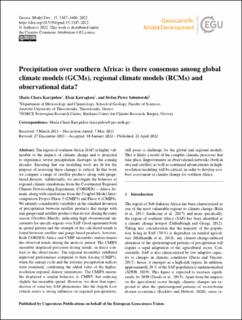| dc.contributor.author | Karypidou, Maria Chara | |
| dc.contributor.author | Katragkou, Eleni | |
| dc.contributor.author | Sobolowski, Stefan Pieter | |
| dc.date.accessioned | 2023-03-30T11:11:10Z | |
| dc.date.available | 2023-03-30T11:11:10Z | |
| dc.date.created | 2022-09-30T13:02:57Z | |
| dc.date.issued | 2022 | |
| dc.identifier.citation | Geoscientific Model Development. 2022, 15 (8), 3387-3404. | en_US |
| dc.identifier.issn | 1991-959X | |
| dc.identifier.uri | https://hdl.handle.net/11250/3061111 | |
| dc.description.abstract | The region of southern Africa (SAF) is highly vulnerable to the impacts of climate change and is projected to experience severe precipitation shortages in the coming decades. Ensuring that our modeling tools are fit for the purpose of assessing these changes is critical. In this work we compare a range of satellite products along with gauge-based datasets. Additionally, we investigate the behavior of regional climate simulations from the Coordinated Regional Climate Downscaling Experiment (CORDEX) – Africa domain, along with simulations from the Coupled Model Intercomparison Project Phase 5 (CMIP5) and Phase 6 (CMIP6). We identify considerable variability in the standard deviation of precipitation between satellite products that merge with rain gauges and satellite products that do not, during the rainy season (October–March), indicating high observational uncertainty for specific regions over SAF. Good agreement both in spatial pattern and the strength of the calculated trends is found between satellite and gauge-based products, however. Both CORDEX-Africa and CMIP ensembles underestimate the observed trends during the analysis period. The CMIP6 ensemble displayed persistent drying trends, in direct contrast to the observations. The regional ensembles exhibited improved performance compared to their forcing (CMIP5), when the annual cycle and the extreme precipitation indices were examined, confirming the added value of the higher-resolution regional climate simulations. The CMIP6 ensemble displayed a similar behavior to CMIP5, but reducing slightly the ensemble spread. However, we show that reproduction of some key SAF phenomena, like the Angola Low (which exerts a strong influence on regional precipitation), still poses a challenge for the global and regional models. This is likely a result of the complex climatic processes that take place. Improvements in observational networks (both in situ and satellite) as well as continued advancements in high-resolution modeling will be critical, in order to develop a robust assessment of climate change for southern Africa. | en_US |
| dc.language.iso | eng | en_US |
| dc.rights | Navngivelse 4.0 Internasjonal | * |
| dc.rights.uri | http://creativecommons.org/licenses/by/4.0/deed.no | * |
| dc.subject | Southern Africa | en_US |
| dc.subject | Southern Afrrica | en_US |
| dc.subject | Klimamodeller | en_US |
| dc.subject | Climate models | en_US |
| dc.subject | Nedbør | en_US |
| dc.subject | Precipitation | en_US |
| dc.subject | Regional klimamodellering | en_US |
| dc.subject | Regional climate modelling | en_US |
| dc.title | Precipitation over southern Africa: is there consensus among global climate models (GCMs), regional climate models (RCMs) and observational data? | en_US |
| dc.title.alternative | Precipitation over southern Africa: is there consensus among global climate models (GCMs), regional climate models (RCMs) and observational data? | en_US |
| dc.type | Peer reviewed | en_US |
| dc.type | Journal article | en_US |
| dc.rights.holder | © Author(s) 2022 | en_US |
| dc.description.version | publishedVersion | en_US |
| cristin.ispublished | true | |
| cristin.fulltext | original | |
| cristin.qualitycode | 2 | |
| dc.identifier.doi | 10.5194/gmd-15-3387-2022 | |
| dc.identifier.cristin | 2057200 | |
| dc.source.journal | Geoscientific Model Development | en_US |
| dc.source.volume | 15 | en_US |
| dc.source.issue | 8 | en_US |
| dc.source.pagenumber | 3387-3404 | en_US |
| dc.relation.project | EC/H2020/774652 | en_US |
| dc.relation.project | Andre: Hellenic Foundation for Research & Innovation grant No. 1323 | en_US |
| dc.subject.nsi | VDP::Geofag: 450 | en_US |
| dc.subject.nsi | VDP::Geosciences: 450 | en_US |

